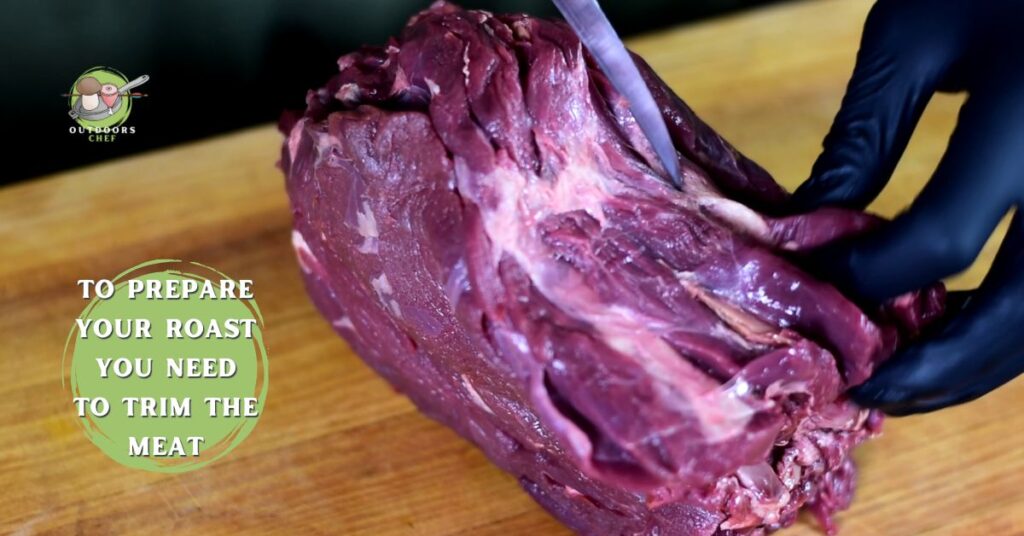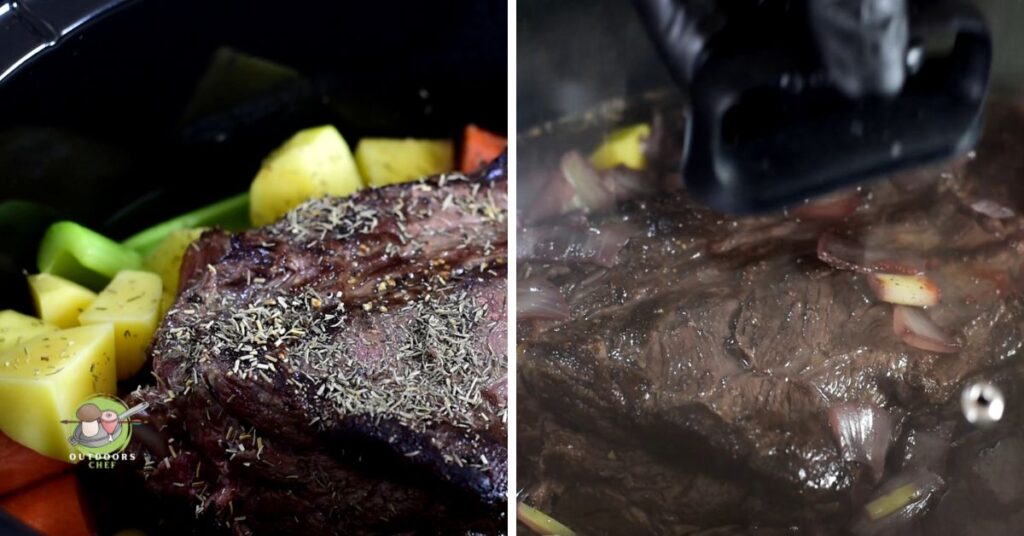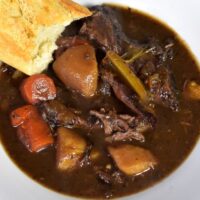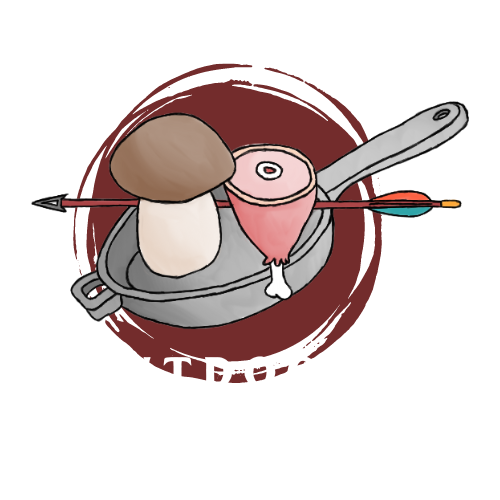How to Cook Venison Roast
Roasts are a popular dish for certain cuts of venison, and if cooked properly are delicious.
There are two methods of cooking venison roasts.
The first method involves cooking the venison in dry heat, while the other cooks the venison roast in low heat and moisture.
The second method is commonly referred to as a pot roast, I will explain how to cook both types in this article.
Selecting the Venison Roast

The first thing you need to do is select the right cut of venison for a roast.
There are a few things to keep in mind when choosing a venison roast.
Technically any cut of venison could be a roast, but larger cuts are preferred as they are easier to cook.
Smaller cuts of venison don’t make good roasts as they quickly dry out.
Typically cuts for roast are the whole hind leg, or the hind leg broken down into individual cuts like the round or top round.
Another cut of venison for roast, and perhaps the best cut is the neck.
Roasts can be boneless or the bone could be left in, you may find leaving the bone in increases the flavor.
However, while it increases the flavor it also increases the cooking time which you will see below.
Preparing the Roast

There’s not much work that goes into preparing a venison roast as most of the action happens during the cooking process.
Generally, you don’t need to marinade venison roasts, regardless of the cooking method you use.
To prepare a venison roast for cooking, the most important thing is trimming.
If you harvested the venison yourself you will need to remove any excess fat and silver skin.
If it’s a venison neck roast there is a big long piece of sinew that needs to be removed at the back of the neck.
To remove this you need to slightly butterfly the back of the neck.
Cooking Methods
Generally, a roast used to be considered cooking a large piece of meat in the oven at high heat.
Nowadays, when people say a roast they are likely referring to a pot roast, which is cooking a medium to large cut of meat at really low temperatures in a moist environment.
Oven Roast

Oven-roasting venison is the harder of the two methods.
Venison is typically a very lean meat which makes it dry out easily when cooking.
To make matters worse, you will need to remove any fat when cooking because venison fat is not very palatable.
Once the venison is trimmed you will need to season the roast. Generally, dry herbs are used for roast venison.
Another common method of seasoning venison roasts is by cutting slits in the roast before rubbing in herbs and spices, then cloves of garlic are shoved into the slits.
While it’s not necessary to sear the roast before placing it in the oven I highly recommend it.
Searing the roast will give a much nicer mailliard reaction than you can get from the dry oven heat.
Steps for oven-roasted venison:
- Trim the meat – venison fat isn’t palatable so removing this will prevent it from pooling on the baking tray. Similarly, you will want to remove any silverskin as this will make the roast chey
- Season the venison – Oven-roasted venison needs to be seasoned before placing in the oven. Using herbs like thyme, and rosemary is a good option as is seasoning like salt, pepper, mustard seeds, etc.
You can also use garlic by cutting slits in the roast and inserting cloves of garlic. Another option and probably the easiest option is to use the wet rub from my rack of venison recipe - Sear the venison – Searing the venison creates a flavor that you can’t get by just oven-roasting the venison.
It’s not necessary to sear the roast but it is highly recommended. There are two options for searing the roast when oven-roasting venison. You can sear before roasting or you can reverse sear the roast.
However, much of this depends on the type of roast. For example, it would work with a roasted backstrap but would be more difficult with a rump roast. - Roast the venison (with some vegetables) – Set the oven to about 325F. Liberally cover the venison in oil if you haven’t already done so when seasoning.
Place in the center of the oven. The cooking time will vary according to the size of the roast so it’s best to cook according to temperature.
I recommend cooking the roast to about 130F if you pre-seared the roast. If you are reverse searing you could pull the roast at 120-125, and sear it. - Rest – Once the roast has reached 130F set it on a wooden block and cover loosely with foil.
Pot Roast/Slow Cooker

While oven-roasting venison is a classic and even the traditional way of roasting venison, pot roast is quickly surpassing it in terms of popularity.
Pot roast venison is not only easier but most likely tastier.
With oven-roasting venison, you have to constantly monitor the roast and continuously baste the meat to prevent it from drying out, while the pot roast is set and forget.
Steps For Pot Roast Venison:
- Trim the roast – Remove the excess fat so it doesn’t pool in your slow cooker. Remove as much silver skin as possible, but the slow cooker is more forgivable than the oven in this case.
- Sear the venison – The venison must be seared before going in the slow cooker, it’s impossible to reverse sear a pot roast.
Liberally oil the venison, preferably with a high-temperature oil. Heat a cast iron, stainless steel, or carbon steel pan over high heat.
Place the roast in the pan and sear all sides until you get a nice browning all over. - Place in pot and cover with ingredients – Once the roast has been seared it’s ready for slow cooking.
All the ingredients can be tossed into the crock pot, this may be herbs and spices, liquids like stock or wine, vegetables, etc.
If you are adding potatoes, wait for a few hours as they will become too mushy if added at the start.
Cook the roast for 8 hours on low for a bone-in roast, about 6 hours for a boneless roast on low.
If you are short on time you can set the crock pot to high and this will remove about two hours from the cooking time.
Side Dishes for Venison Roast

A venison roast is a delicious dish on its own but will work much better with side dishes.
If you are making a venison oven roast it’s likely that you will roast it with vegetables like carrots, parsnip, or even potatoes.
These vegetables make a perfect side dish and you don’t really need anything else.
The same is true for a pot roast except the veg is slow cooked with the meat.
However, if you don’t add the veg in the oven or you’re making something like a Mississippi pot roast that doesn’t have veg you will need some side dishes.
The most common side dish for venison roast is buttery mashed potatoes.
This is a perfect bed for a pot roast and also goes well with an oven roast.
Another option for an oven roast is to make roast venison sandwiches.
Pot roasts also work well with bread, but rather in the form of baguettes for dipping into the gravy.

How to Cook Venison Roast
Ingredients
- 4 pounds venison neck bone in or boneless see note 1
- 4 cups venison stock
- 2 cups red wine see note2
- 3 carrots cut into 1 inch pieces
- 2 sticks celery cut into 1-1.5 inch pieces
- 1 large onion diced large
- 1 pounds potatoes cut into 1 inch cubes
- 3 clove garlic minced finely
- 1 teaspoon dried rosemary
- 1 teaspoon dried thyme
- 2 teaspoons soy sauce
- 2 teaspoons Worcestshire sauce
- 2 teaspoons tomato puree
- 2 bay leaves
- 1 teaspoon kosher salt
- 1 teaspoon cracked black pepper
- 2 tablespoons cornstarch
Instructions
- Heat a skillet over medium high heat
- Liberally oil the venison neck and rub in the salt and pepper
- Brown the neck on the skillet, not turning until it naturally releases. (appox 5-7 minutes total)
- Remove the venison and place into the Crock Pot.
- Reduce the heat on skillet and add in onions and garlic, cook for 2 minutes until lightly browned.
- Add the wine to the skillet scraping up all of the brown bits. Reduce wine by half.
- Pour all contents from skillet into the slow cooker.
- Add in all the other ingredients EXCEPT cornstarch
- Cover the Crock Pot, set to low and cook for 8 hours
- Remove the meat to a cutting board and separate the meat from the bone if using a bone in roast. The meat should separate easily.
- Strain the gravy into a sauce pan using 3-4 tablespoons of gravy in a separate bowl add the cornstarch and make a slurry
- Return the slurry to the saucepan and stir over a medium heat until the gravy reaches your desired consistency.
- Serve meat and veg with gravy poured on top
Notes
- This recipe can be made with bone in or boneless roast. I find that leaving the bone in gives a little more richness to the dish.
- If you do not want to use wine you can substitute for 1 cup of stock and skip the reducing part







